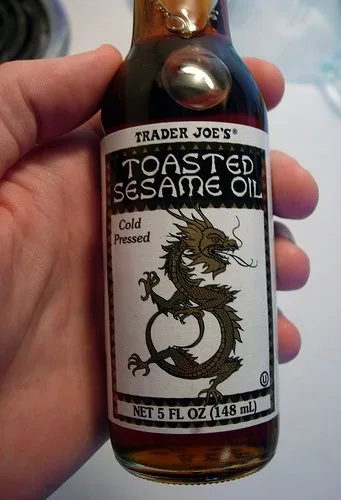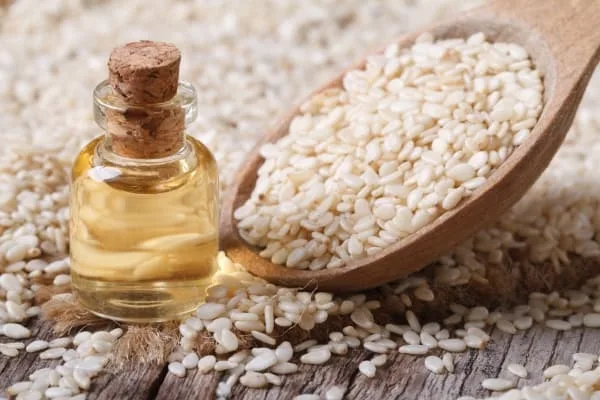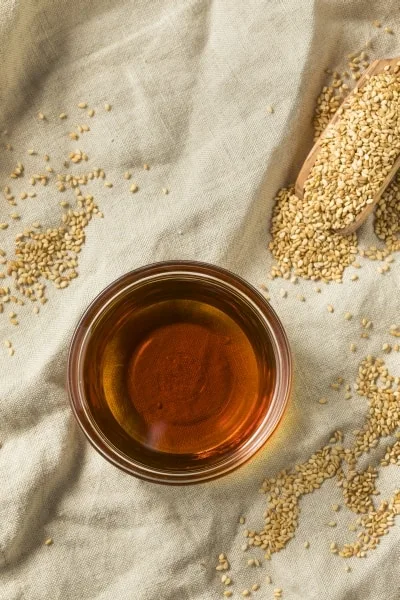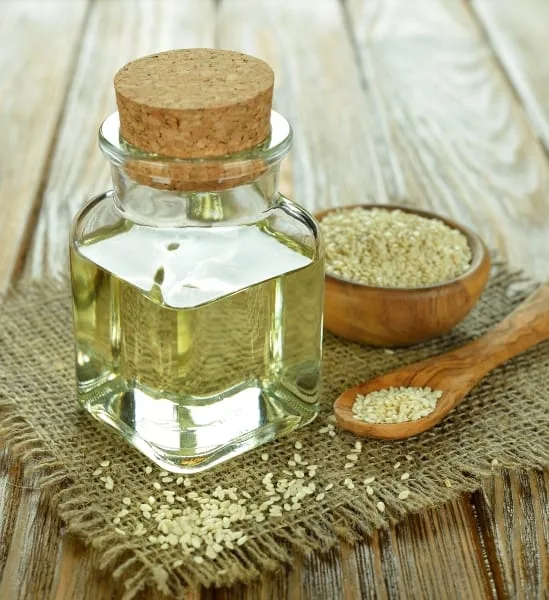Today we’ll cover the shelf life, storage, and spoilage of sesame oil.
Say you bought a bottle of sesame oil quite a while ago, and it’s still sitting in the cabinet months beyond the printed date. Does sesame oil go bad, and if so, how can you tell?
Or maybe you’ve just opened a fresh bottle you purchased for your stir fries, and you need to know how long toasted sesame oil lasts.
Sounds like you?
If so, this guide will answer all your sesame oil-related questions. Let’s dive right in.

Table of Contents
- Does Sesame Oil Go Bad?
- How to Tell if Sesame Oil Is Bad?
- Does Sesame Oil Need to Be Refrigerated?
- How to Store Sesame Oil
- How Long Does Sesame Oil Last
- Sesame Oil Shelf Life and Spoilage Summary
Does Sesame Oil Go Bad?
Yes, sesame oil spoils, and the most common way that happens is by going rancid. Rancidification is an ongoing process accelerated by air, light, and heat, but given enough time, the oil will go rancid even if unopened and well stored.
(The same is true for other oils, including grapeseed, canola, or your regular cooking oil.)
Rancid oil typically tastes harsh and bitter, and often smells “funny.” That makes it useless for cooking (plain sesame oil) and finishing dishes (the toasted variety).
That said, ingesting a bit of rancid oil isn’t a big deal in the short term – you won’t get sick or spend the evening on the toilet. But it’s suspected that eating rancid fats (in large quantities) might have negative long-term ramifications, so it’s best to stay away from them.
(Tasting a bit shouldn’t be an issue, so don’t worry.)
Obviously, the oil being rancid isn’t the only possible spoilage sign. Let’s talk about others.

How to Tell if Sesame Oil Is Bad?
Discard sesame oil if:
- The smell has changed. If your oil doesn’t smell how it used to (or is supposed to), it’s probably rancid. For reference, plain sesame oil has a pretty neutral aroma, while toasted sesame oil smells toasty and nutty, similar to what toasted sesame seeds smell like (duh).
- The taste is sharp or bitter. Those two are the hallmarks of rancid oil, and it’s no different for sesame oil. Again, regular sesame oil should have a neutral flavor (like any other cooking oil), while the toasted variety should taste toasty and nutty. Please note that rancidification is a gradual process, so there’s a spectrum of flavor, and I suggest you use yours as long as you find the taste good. Or at least acceptable.
- You find anything nasty in the bottle. Oils and fat-based products don’t grow mold unless you “help” them. But if you accidentally contaminate the oil, all bets are off. Check the bottom of the bottle, the surface of the oil, and the neck just to be sure. And if you happen to refrigerate sesame oil, it might get cloudy, but that doesn’t mean it’s spoiled.
- It messes up your cooking. If you didn’t check the oil before cooking, but whatever you cooked turned out bitter or off-tasting, the oil might be the culprit here. The same is true if you’ve added your toasted sesame oil to a stir fry or used it to finish your salad. If either is the case, taste the oil to check its quality.
Finally, if anything else about the oil feels off, or it’s like two years beyond its date and you want nothing to do with it, toss it. Better safe than sorry.
Next up, let’s talk about whether you should store your sesame oil in the fridge.

Does Sesame Oil Need to Be Refrigerated?
You don’t have to refrigerate sesame oil, but it’s worth considering if it’s the toasted variety, or if you don’t have a fairly cold storage space and it’s the middle of a hot summer. Of course, you can also refrigerate it to retain quality for longer.
(Similarly, you don’t have to refrigerate tahini, but it’ll help extend its storage time.)
Now, there are a lot of sesame oil producers out there, and the storage instructions they provide differ a bit. Some clearly state that a cool and dry place is good enough. Others suggest refrigeration or placing the oil in the fridge after opening.
It’s a toss-up.
If you’re still not sure how to go about it, here’s what I suggest:
- store plain sesame oil in the pantry
- refrigerate toasted sesame oil after opening the bottle
Toasted sesame oil is typically used as a finishing oil. If you store it in the fridge, consider warming it up to room temperature before using it so that you don’t pour cold and cloudy oil all over your roasted veggies (or what have you).
Having that out of the way, let’s talk about other storage practices.

How to Store Sesame Oil
Store sesame oil in a cool and dry place, like a cabinet in the pantry or kitchen. After opening the bottle, consider refrigerating the oil, especially if it’s the toasted kind.
No matter where you put it, remember that oxygen, light, and heat speed up rancidification.
That means the bottle should be sealed tight when not in use, stored outside direct sunlight, and away from any heat sources, such as the stove.
As you can tell, storage is not rocket science, and the practices outlined above are pretty much the same for other vegetable oils, too.
If you follow them, your sesame oil should easily last beyond the printed date.
Speaking of which, let’s talk about storage time.

How Long Does Sesame Oil Last
Sesame oil lasts about 2 years if unopened and around 6 months after opening. That assumes you store it in a cool place away from heat sources and sunlight.
Those periods are, of course, conservative estimates. So if you store your sesame oil properly, chances are yours will keep for at least a couple of extra months without deteriorating in quality.
In case you’re wondering, an unopened bottle keeps for much longer than an open one because the oil doesn’t have access to fresh air. That changes after you first open the bottle, and that’s what causes the shortening of storage time to about six months.
All in all, any dates and periods I (or anyone else) could give you are only rough approximations. They’re helpful as guidelines, but that’s about it.
A better approach is to pay attention to the spoilage signs I listed earlier. If the oil doesn’t show any, chances are it’s okay to use, no matter the printed date. The opposite is also true – if there’s something off about it, you toss it, even if it’s a freshly open bottle that you stored properly.
Finally, toasted sesame oil sometimes has a shorter storage time than its untoasted counterpart. That’s because the seeds used to make the oil were already toasted, and as you know, fats deteriorate more quickly in warm temperatures.
But again, the fact that the label says so doesn’t mean the oil will actually turn rancid sooner. Pay attention to the oil’s quality, and maybe choose a smaller bottle if you’re not using it often, is all.
Sesame Oil Shelf Life and Spoilage Summary
Thanks for reading this primer on sesame oil. Here are the takeaways:
- Sesame oil goes rancid if stored for long enough or in bad conditions. You can tell that yours is rancid if it tastes sharp or bitter. It might also give off a chemical-like aroma, but that’s not always easily discernible, especially for the toasted variety.
- Refrigerating sesame oil isn’t necessary, but it’s a good idea if you don’t have another cool storage place available, or the oil is toasted and you need it to retain quality for more than a couple of months.
- Sesame oil lasts about 2 years unopened and 6 months after opening the bottle. Those are rough estimates, and if you store yours properly, it’ll likely retain quality way beyond those periods. Instead of trusting the dates, give the oil a good check before using, and if everything is in order, continue using it.